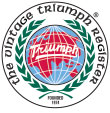TR6 Seatbelts Guide
by Ken Streeter,
with input from Paul Burr , Joe Flake , Glenn Franco , Bill Georgas , Roger Helman , Daniel Julien , Chris Kantarjiev , Bruce Krobusek , Martin Libhart , Tom Marincic , Chet Masterson , Bob McCarty , Jim Ruwaldt , Bill Stockdale , and Bill Wood
The TR6 used two main different types of seatbelts throughout it’s production lifetime, and at least four minor variations. Documentation for changeover points for seatbelt configurations is somewhat lacking among the US Parts Suppliers, even in the extremely complete 2-volume “Triumph TR6 Spare Parts Catalog and Engineering Assembly Manual” published by The Roadster Factory. The TRF catalog does list four different factory part numbers for seat belt kits.
The Two Primary Types of TR6 Seat Belts
Early TR6s used “static” seat belts, with either a 2-point (lap belt only) or a 3-point safety harness. The 2-point belt connected to mounting “eye bolts” near the transmission tunnel and the rear door post (B post.) The 3-point harness used the 2-point mounting hardware, with an additional pivot bolt on the rear wheel arch. At least two different types of 3-point harness mounting hardware existed, with an switchover point unknown to this author.
Late TR6s used an “inertial reel” 3-point seat belt. This harness uses slightly different mounting hardware from the static safety belts, but at the same mounting points. The one addition to the system is the “inertial reel” itself, which was mounted against the rear wheel arch and parcel shelf at the junction of these two pieces. Bill Stockdale indicates that the belts in his car (CC78607) were made by a company called Kangol in Carlisle, Cumbria, England. The company is still in business but specializes in designer hats!
In April 1997, a number of triumphs mailing list readers tried to narrow in on a potential switchover point from the static to the inertial reel seat belts. In this discussion, the following excerpt from the Triumph Sports Owners Association (TSOA) June 1972 (18:6) newsletter was uncovered:
“There appears to be some confusion regarding the correct operation of current inertia type seat belts fitted to our vehicles after January 1972. These belts are vehicle sensitive as operation is concerned, and this simply means that they allow the occupant complete freedom of movement under all normal operating conditions, but in the event of sudden deceleration the belt will lock.
In order to check for correct operation of this system, drive the vehicle at low speed and apply the brakes suddenly and at the same time lean forward on the harness. Under these conditions the belt should lock automatically.”
The above note indicates that inertial reel belts were introduced in January, 1972. Some members of the Triumphs mailing list believed that thay may have been an option even before that, but no factory documentation on this has been uncovered to this author’s knowledge.
The triumphs mailing list members also conducted an informal survey of TR6 owners to see what cars near the switchover point had for seat belts: (If you have a car that falls into the range listed below, please send the information on your car to Ken Streeter, streeter@www.vtr.org .)
|
TR6 SEAT BELT TYPES |
|||
| Commmision Number: | Mnfr Date (Model Year): | Belt Type: | Owner: |
| CC67866 | Aug 1971 (1971) | Static | Roger Helman |
| CC75128 | Sep 1971 (1972) | Static | Joe Flake |
| CC75322 | Sep 1971 (1972) | Static | Martin Libhart |
| CC75665 | Sep 1971 (1972) | Static | Bruce Krobusek |
| CC78022 | Dec 1971 (1972) | Static | Bob McCarty |
| CC78196 | Dec 1971 (1972) | Static | Bill Wood |
| CC78607 | 21 Dec 1971 (1972) | Inertial Reel | Bill Stockdale |
| CC78709 | Dec 1971 (1972) | Inertial Reel | Dan Julien |
| CC79173 | Jan 1972 (1972) | Inertial Reel | Chet Master |
| CC79338 | Jan 1972 (1972) | Static | Jim Ruwaldt |
| CC85458 | ??? (1972) | Inertial Reel | Bill Georgas |
Modern Replacements
The webbing of the factory seat belts does not seem to withstand the test of time very well, and quickly becomes discolored, frayed, or torn. Furthermore, the inertial reel seat belts frequently become stuck or fail to lock as they should. The author highly suggests that worn out seat belts be replaced immediately for obvious safety reasons!
Each of the “big three” USA Triumph parts suppliers sells a seat belt suitable for use in the TR6:
- Moss Motors sells a 3-point static seatbelt which is suspected of being a bolt-in replacement for the early style seatbelts. Bruce Krobusek of the triumphs mailing list is experimenting with installation of this belt. He encountered difficuly on his car with removing the mount point to install the belt, but also mentions that Moss sells a clip-on version which may work better. Tom Marincic also reports that these belts worked well in his TR250.
- The Roadster Factory sells a reproduction of the 3-point inertial reel seatbelt. This is purported to be a reproduction bolt-in replacement for the original inertial reel seatbelts as fitted to later TR6s.
- Victoria British sells a 3-point inertial real seatbelt which looks like it could be readily fitted to the later TR6s, although it is not particularly similar to the stock harness.
Also, Chris Kantarjiev reports that there are companies that will reweb seatbelts, allowing one to keep their original hardware. One company that used to be well regarded is called Arise — you can find more information on the British Car Parts, Publications, and Services List .
Finally, Paul Burr reports that the seat belts from an ’84 RX7 were a bolt-in replacement for the TR6 inertial reel seat belts. He also thinks the rear seat belts in the newer Jeep CJ7 may be a close fit.
